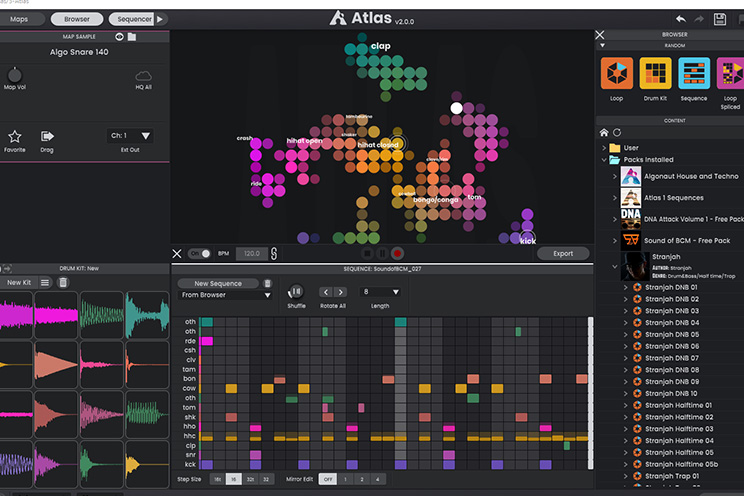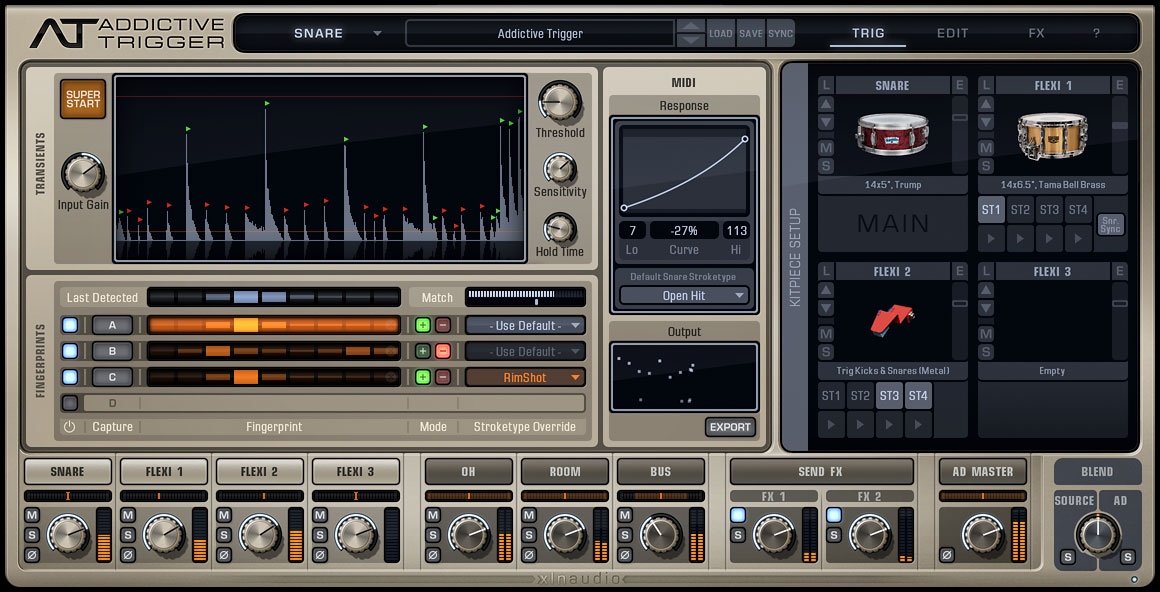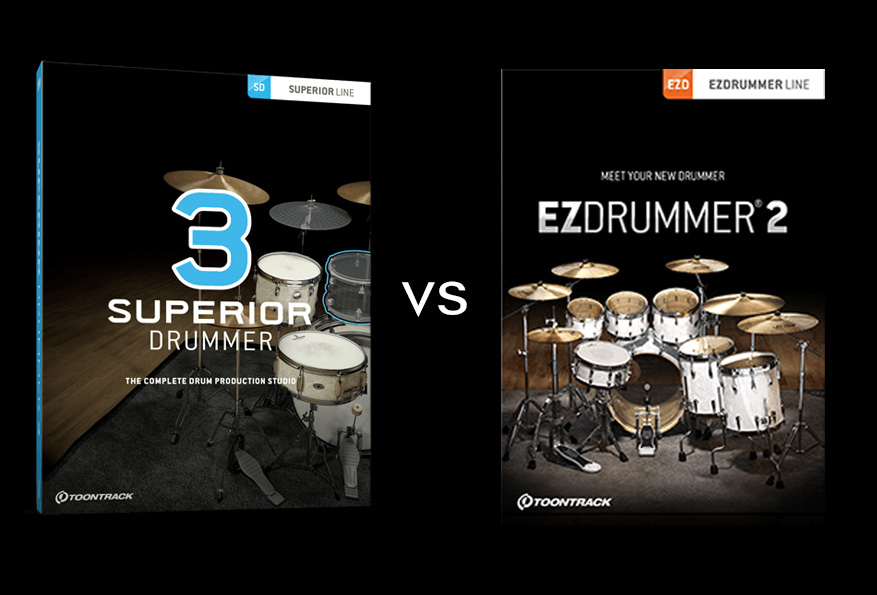Plugin Boutique Scaler 2 Review – Our Verdict
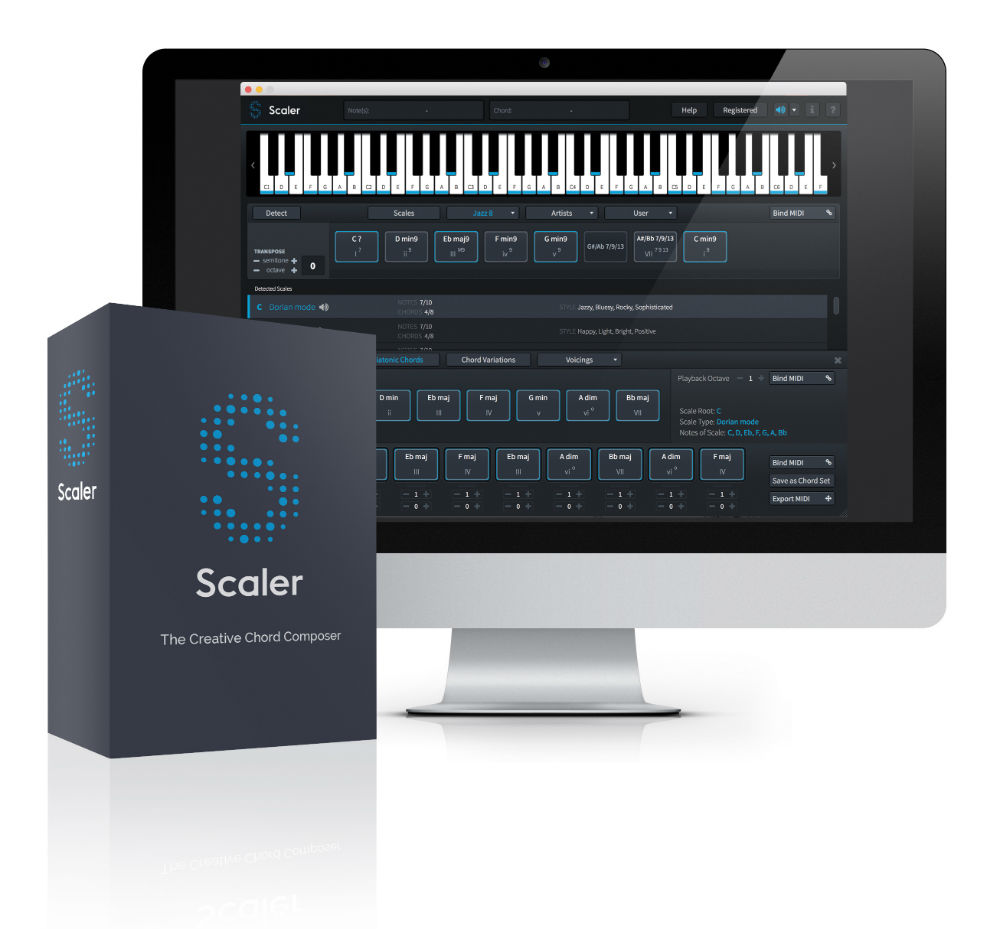
Scaler 2 is an impressive music-theory plugin that we think will make music composing and production a lot easier for beginners, while also serving as an advanced tool for experienced composers.
After playing around with Scaler 2 since its release, I have decided to write my opinions on the plugin. Scaler 2 is a step above most other music-theory plugins that I have ever used.
Contents
Scaler 2
The plugin allows you to select a scale (for example, C Minor, G Major, or many more advanced variations) and build chord progressions and melodies based on that. It includes some great performance and dynamic playing options to add a lot more depth and rhythm to your expressions.
Scaler 2 can also be used as a virtual instrument, as well as being a MIDI source to other virtual instruments. It includes some great sounding pianos, synths, guitars, orchestras, and hybrids out of the box.
Scaler 2 would be great for beginner composers and producers that don’t know much about music theory, as well as those with a lot of music theory knowledge that want to speed up their workflow, explore more exotic scales, and/or come up with new creative ideas.
If you don’t know the key of a track, you can use the automatic key/scale detection of both MIDI and Audio, which works very well.
It is a fantastic music composition and learning tool, which can be used not only by those who aren’t too much into music theory, but also by those who are willing to learn, to expand their knowledge not just in terms of scales and chords, but also in terms of music theory in general.
Scaler 2 offers an enormous library of chords and scales, pretty much everything we know in music today. However, the beauty of this software isn’t in that impressive amount of data, but in its ability to come up to you with suggestions that can completely change the way you make music.
Simply said, this is a super-practical tool, with great learning potential.
Before we get into it, have a look at this video to see a nice demo of it in action:
How Scaler 2 Works
The plugin is made up of the following main groups of features.
- Key Detection: Both audio and MIDI
- Selecting scales and chord-sets: Based on manual selection OR by selecting some pre-set scales and chord-sets based on your song type or by successful artists (very impressive feature).
- Performance: Scaler 2 also has a ton of performance options such as expressions, arpeggios, and strumming patterns that can add a lot of life to your tracks.
- Build your own chord-sets: You can build and import your own chord-sets, so you can use this as a great tool for your workflow.
Scaler 2 has an absolute ton of features, but this article is not intended to be a tech spec of each of them.
We’re going to go through what we think are the most important parts of this plugin.
Key Detection
Scaler 2 can automatically detect the key and scale by MIDI (either through playback in your DAW or by playing a MIDI keyboard for example) or Audio (also through playback of audio files or while recording real-time through an audio interface).
A great thing about the detection process is that it will show you a number of both exact and close matches of scales. The closest matches will be ranked at the top, but the plugin will also suggest a list that includes scales and chords that aren’t perfect matches, but rather miss a couple of notes.
Selecting Scales and Chords
There are a few different ways that you can select scales and chord sets. First off, you can select these manually. Let’s say you want to write a song in C Minor. Just simply select this from the scales list, like below.
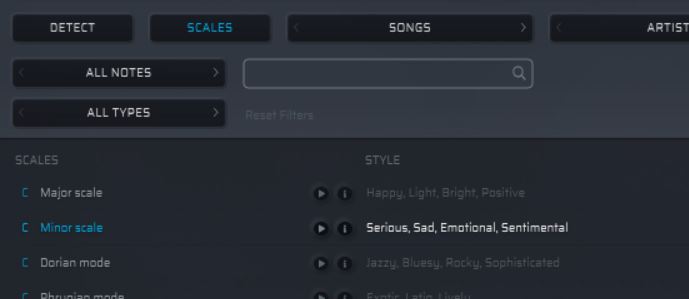
Scaler 2 also helps you by telling you that the C Minor has a ‘Serious, Sad, Emotional, Sentimental’ style. You might already know that for such a standard scale, but these ‘style’ labels are very useful when you want to explore some more advanced and exotic scales.
When it comes to chord-sets, you can choose between a bunch of different options such as standard diatonic chords (such as triads, 7ths, etc), or simply just selecting from many other presets under voicings, variations, and modulations that can make your chords a lot more interesting and unique for your track.
This is incredibly easy to do without any music theory knowledge. Without Scaler 2, this would require a vast amount of music knowledge and years of experience.
Alternatively, you can also select scales and chord sets based on presets in the ‘songs’, ‘artists’, and ‘user’ drop-downs, which give you a massive amount of different options to play around with straight out-of-the-box.
These buttons are shortcuts to a large library of pre-selected notes and chords. For example, the Artist button includes a lot of presets that were made by renowned artists like Carl Cox, Josh Abrahams, and MJ Cole.
These presets are an excellent starting point if you need a bit of inspiration. They can also serve as great learning tools as well, considering that you can modulate these presets in so many ways. The more you experiment, the more you can get out of these.
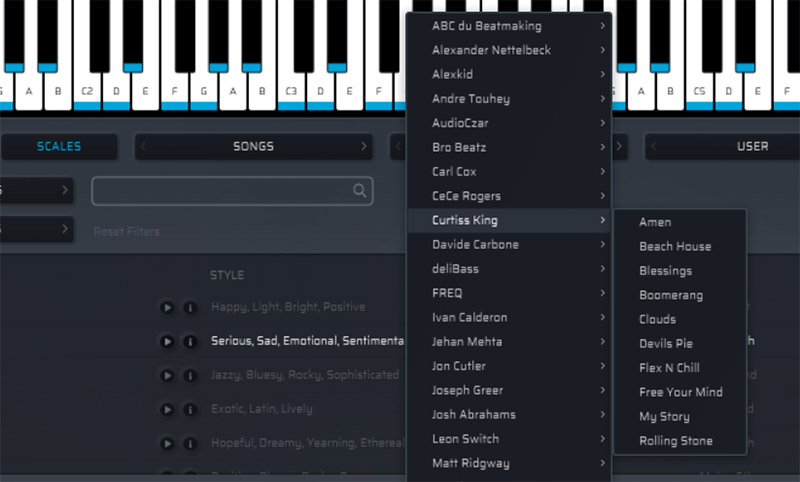
Performance and MIDI Capturing
Playing Chords
Once you have your scale and chord-sets selected, you can start playing.
The first thing most people will want to do is to start playing some chords. Simply press the ‘B’ button on the lower left, which binds incoming MIDI notes to chord triggers.
This means that hitting a note on your midi or computer keyboard will trigger a chord to play.
To make things even more interesting, you can choose a voice grouping, such as ‘Dynamic’, which will add a bass note on a lower octave for every chord you play, which is commonly done in many styles of music.
If you have a MIDI keyboard, you can now play full chords by just pushing one key with your left hand, and you can play melodies on top of it with your right hand.
Capturing MIDI
There are two ways of capturing MIDI from Scaler 2. Capturing MIDI to your DAW will allow you to make full MIDI arrangements for your tracks. It also will allow you to alter the MIDI however way you see fit.
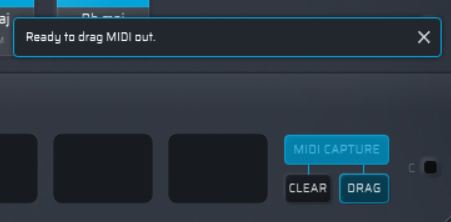
1. You can use the MIDI Capture feature at the bottom right to start recording the MIDI output from the plugin (e.g. chords and melodies). When finished, you just simply drag the MIDI out to a MIDI track in your DAW.
2. Alternatively, you can set the MIDI input of a MIDI track within your DAW to Scaler 2, which will route the output of Scaler into that track. That’s a great approach if you want to record a long session and don’t want to manually midi capture every time.
Virtual Instruments within Scaler 2
Most people would buy Scaler 2 for the purposes of capturing MIDI and using that with favorite virtual synths and samplers. It’s perfect to use it in this way.
However, you might be surprised to know that Scaler 2 actually includes some great sounding virtual pianos, synths, guitar, and orchestra sounds all on its own. For example, the ‘Felt Piano’ virtual instrument sounds fantastic.
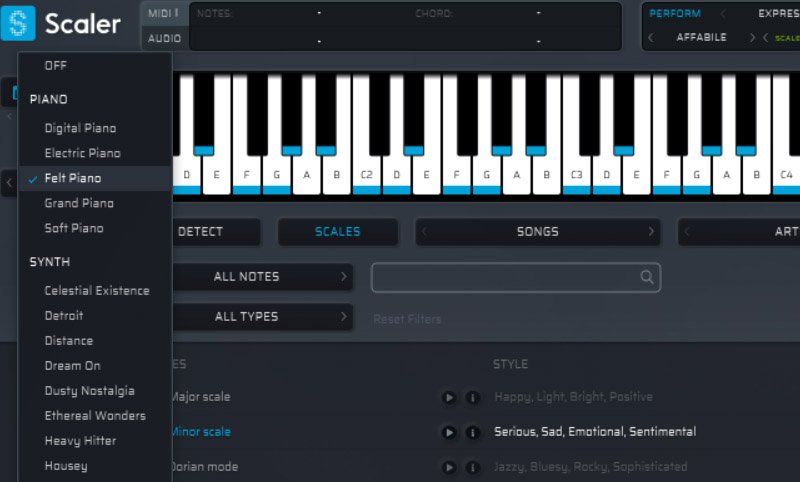
Playing Melodies
You can quickly perform some great melodies lines using the ‘keys-lock’ feature. By selecting ‘scale notes mapped’, then any note that you hit will be mapped to a correct note within the scale.
Even more interesting is the ‘Chord Extensions’ option, every time you press on a ‘chord key’ with your left hand, it changes the mapping of the keys on your right hand to the extended keys of that chord. Have a look at the video below (at the timestamp 16:09) to get a better idea of how that works. It’s a fantastic feature.
Performance Options
Scaler 2 also has a ton of performance options such as expressions, arpeggios, and strumming patterns that can add a lot of life to your tracks.
Simply select one of these and hold down a key and it will start the pattern. I was pretty impressed by just how many great patterns that are included with Scaler 2. If you don’t want to copy a pattern exactly, you can capture the MIDI from it, copy it into your DAW, and then play around with the phrases manually.
Humanize
Computer-made music can sound very metronomic. If you want to add a bit more of a human element to your playing, you can select from the Humanize options to add subtle changes to the note velocity, timing, or both.
Guitar Note View
If you prefer to see notes laid out in a guitar view, then just click the Guitar Icon at the top left. You can also change the note layout to many different tunings, such as Standard, Open C, Drop D, etc.

Our Verdict
We have been very impressed by Scaler 2. The first iteration of Scaler was already very useful, but the second version really built on these features.
Who is Scaler 2 useful for?
Scaler 2 is useful for a few different groups producers/composers (I’ll refer to these as ‘users’ in this section):
- Beginner users that don’t know much about music theory
- Experienced users without much music theory knowledge
- Users with a lot of music theory knowledge that want to speed up their workflow, explore more exotic scales, and/or come up with new creative ideas.
Based on the vast amount of features, scale/chord selection, and performance options. This is an almost perfect music composition tool for beginner producers, composers, and those without a lot of music theory knowledge.
If you feel that every track you are producing is using the same dull chord triads and boring melodies, then Scaler 2 might be a great opportunity for you to get out of a creative rut.
However, Scaler can also be a great tool for those who already have a good understanding of music theory. Scaler 2 can allow them to go beyond their knowledge or even try to compose in a completely new genre. For example, musicians who prefer jazzy sound but don’t know much about uncommon scales and modes, don’t have to big chord vocabulary, etc.
It’s also great for advanced users that want to speed up their workflow. You can create your own chord-sets and save them in your user presets. Also, if you find that your music often uses similar expressions to the ones found in Scaler 2, then you can quickly create MIDI patterns that follow these without having to create them manually.
Scaler 2 contains so many scales, chord-set presets, and performance options, that it would still be very useful for advanced composers that need some inspiration for new ideas.
Conclusion
Scaler 2 has a deep amount of features for music composition, while still being quite easy to use. It’s an affordable and impressive plugin that would be useful for both beginner and advanced composers and producers.


